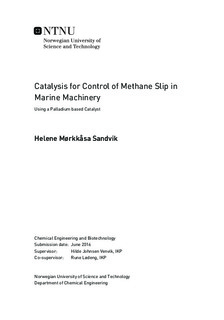| dc.description.abstract | In a world distributing more and more liquefied natural gas (LNG), due to it`s advantages within health, environment and energy compared to gasoline and diesel, it is favourable to research more within this area. The main objective of this study is to find an extra route to the conventional high-temperature burning of methane (main component in LNG) in the marine machinery, in which produces noxious by-products. The engines existing today achieves very low NOx-emissions at high efficiency, but emits low concentrations of CH4. Methane is a greenhouse gas with 20 times the global warming potential of CO2 and measures to improve the methane slip abatement by catalytic oxidation of methane using palladium supported catalysts will be studied. Pure palladium catalysts are expensive, therefore the studied catalysts are supposed to be used as references when exploring the opportunities within activity of palladium based catalysts mixed with other metals, such as nickel, or catalysts using small smounts of palladium or not using palladium at all.
Three catalysts were prepared using incipient wetness impregnation with a solution of palladium nitrate and γ-alumina, including two 0.2 wt% Pd/Al2O3 catalysts and one 2.0 wt% Pd/Al2O3 catalyst. The catalysts were characterized using Nitrogen Adsorption, X-Ray Fluorescence, Chemisorption with H2 and CO, X-Ray Diffraction and Thermogravimetric Analysis, to find the catalysts` chemical and physical properties. Their activities were tested by loading the catalysts into a reactor and install it in a setup for methane oxidation. The gas feed consisted of various compositions of methane, oxygen and nitrogen at 1 bar and the temperature was raised from room temperature and up to the temperature needed to achieve practically complete methane conversion. Deactivation experiments were also performed by running the reactions in series and comparing the temperatures where 100% methane conversion was achieved, T100%. An increased T100% can reveal the extent of the catalysts deactivation, as the reaction is irreversible and extremely exothermic.
The results from the testing showed that the catalyst with the highest loading, i.e. 2.0 wt% Pd/Al2O3, performed the best when comparing the catalysts at the same reference conditions, such as using fresh catalyst, a constant total molar feed flow equal to 200 NmL/min and inlet gas composition of methane/oxygen/nitrogen equal to 2%/10%/88%. The T100% was increased from 437 ºC to 541 ºC for the 2.0 wt% and 0.2 wt% catalysts, respectively. The lowest T100% equal to 317 ºC was achieved when the air/fuel-ratio was 10 and the inlet gas flow composition of methane/oxygen/nitrogen was 0.1%/1%/98.9%. The catalysts showed the same trends where the lowest T100% was achieved under lean conditions and air/fuel-ratio equal to 10. The results suggest that the palladium particles are more active in an oxygen rich environment, i.e. lean burn and A/F-ratio equal to 10, and it may correspond to bulk- or surface-oxidation of the Pd particles becoming more active. The TGA-results showed that the palladium stores a lot of oxygen. No by-products such as CO were detected, hence the selectivity is equal to 100% under all conditions. The high activity can be explained by well dispersed metal particles on the γ-alumina surface, which is in agreement with the CO-chemisorption and XRD results. As the XRD and XRF did not show any impurities and it is therefore expected that the preparation method was good enough to remove organic molecules and nitrates.
The observed activity loss when testing the catalysts for deactivation may be due to sintering, and further analyses on the spent catalysts should be performed. The T100% increased by 83 ºC after all runs had completed for the 0.2 wt% compared to the 2.0 wt% which increased by 32 ºC. The ignition temperatures of the reactions are supposed to be at almost the same temperature as the outlet of the machinery to save energy, and the observed temperatures were relatively low. | |

